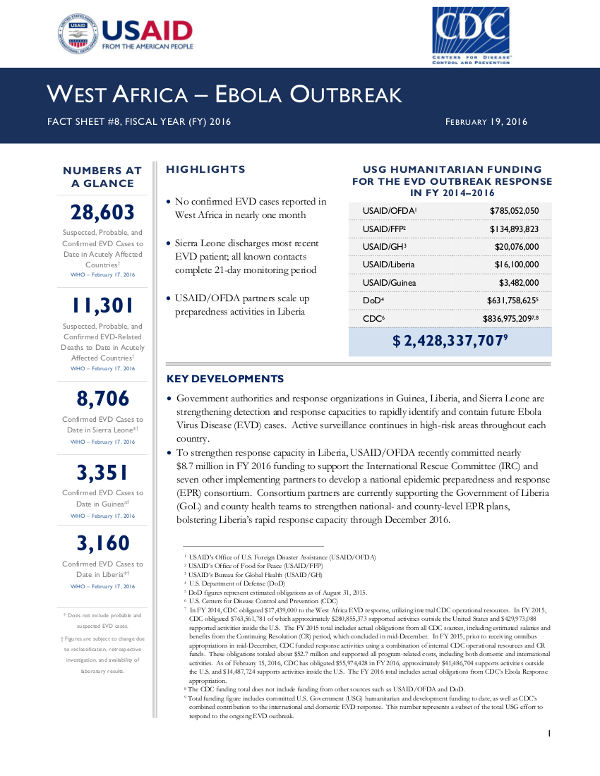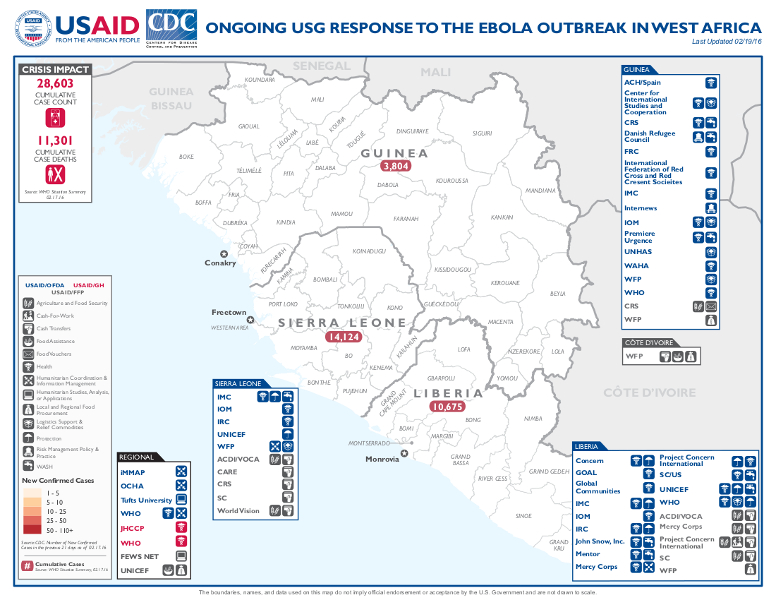Speeches Shim
February 19, 2016
HIGHLIGHTS
Ebola Response
Visit our main West Africa Ebola Outbreak page to learn more about how we're responding to the West Africa Ebola outbreak, and what you can do to help.
- No confirmed EVD cases reported in West Africa in nearly one month
- Sierra Leone discharges most recent EVD patient; all known contacts complete 21-day monitoring period
- USAID/OFDA partners scale up preparedness activities in Liberia
KEY DEVELOPMENTS
- Government authorities and response organizations in Guinea, Liberia, and Sierra Leone are strengthening detection and response capacities to rapidly identify and contain future Ebola Virus Disease (EVD) cases. Active surveillance continues in high-risk areas throughout each country.
- To strengthen response capacity in Liberia, USAID/OFDA recently committed nearly $8.7 million in FY 2016 funding to support the International Rescue Committee (IRC) and seven other implementing partners to develop a national epidemic preparedness and response (EPR) consortium. Consortium partners are currently supporting the Government of Liberia (GoL) and county health teams to strengthen national- and county-level EPR plans, bolstering Liberia’s rapid response capacity through December 2016.
Regional
The governments of Guinea, Liberia, and Sierra Leone reported no known EVD cases or contacts under precautionary observation as of February 17. Government authorities and response organizations in all three countries are conducting interventions to strengthen broader emergency health capacity and bolster each country’s ability to respond effectively to future EVD and other infectious disease outbreaks.
Sierra Leone
Health care workers discharged Sierra Leone's most recent EVD case from the 34 Military EVD treatment unit in Sierra Leone’s capital city of Freetown on February 5, following two consecutive EVD-negative test results. As of February 10, approximately 116 contacts of the country’s two mid-January cases had completed a 21-day monitoring period. Pending no new confirmed cases, the UN World Health Organization (WHO) plans to declare the end of Sierra Leone's recent EVD outbreak on March 17.
A Government of Sierra Leone (GoSL) campaign to vaccinate contacts of the index case, as well as secondary contacts and other targeted community members, reached approximately 200 people across Bombali, Port Loko, and Tonkolili districts as of late January, the GoSL reports. In Kambia District, as many as 20 community leaders had received the vaccine as a confidence-building measure for affected areas as of February 2
West Africa Map - 02-19-2016 ![]() (pdf - 554k)
(pdf - 554k)
Guinea
From February 15–19, the U.S. Embassy in Conakry is hosting a conference for the Global Health Security Agenda (GHSA)—a USG effort to both prevent and quickly respond to global disease outbreaks and promote global health security as an international security priority. Conference attendees include representatives from the Government of Guinea (GoG), USAID/OFDA, CDC, DoD, National Institutes of Health, other donors, and international nongovernmental organizations. In collaboration with USAID/Guinea, CDC, and other USG agencies, USAID/OFDA is coordinating with the GHSA to transition USG assistance for Guinea’s EVD outbreak from emergency response activities to long-term recovery efforts, including strengthening local health systems to respond to future EVD and infectious disease outbreaks. The U.S. Embassy in Freetown also hosted a GHSA conference in recent weeks.
During the week of February 1, USAID/OFDA partner the International Organization for Migration (IOM) commenced new community event-based surveillance (CEBS) activities in Forécariah Prefecture, one of Guinea’s most acutely EVDaffected regions and a priority area for ensuring residual capacity to identify and treat potential new EVD cases. The GoG has designated CEBS—which engages communities to identify and report EVD cases, thereby rapidly activating response mechanisms to stop new transmission chains—as a national priority for 2016, in line with the WHO Phase 3 strategy for regional EVD response and recovery efforts. In coordination with implementing partners, including IOM, the GoG is currently managing a countrywide rollout of CEBS activities.
Through its partners, USAID/OFDA is supporting GoG efforts to strengthen community-level epidemiological data collection and management. For example, IOM staff are providing CEBS training and supervision in Forécariah, as well as conducting a village-level assessment to identify households' vulnerability to public health risks. USAID/OFDA is also supporting Accion Contra el Hambre (ACH)/Spain to conduct CEBS activities in Forécariah, including supporting approximately 370 community agents to conduct epidemiological reporting.
Liberia
USAID/OFDA activities remain focused on strengthening GoL Ministry of Health (MoH) capacity to identify and contain future EVD cases since WHO declared an end to Liberia’s most recent EVD outbreak on January 14.
With nearly $8.7 million in FY 2016 assistance, USAID/OFDA is supporting IRC and seven other implementing partners to develop a national EPR consortium, bolstering Liberia’s rapid response capacity through December 2016. Since the consortium’s launch in early January, USAID/OFDA partners have supported GoL efforts to finalize the national EPR plan; convened preliminary meetings to delineate roles, responsibilities, and early deliverables; and coordinated with health teams in all 15 counties to improve county-level EPR plans.
The consortium is mapping areas of operation and organizations’ planned activities to identify EPR gaps and prevent duplication. International Medical Corps (IMC)—an EPR consortium member—plans to pilot rapid response trainings in Bong and Margibi counties in the coming weeks, and additional partners intend to commence rapid response trainings in other counties based on gaps identified by county health teams.
USAID/OFDA partner Global Communities transferred the management and operational support duties of the Disco Hill national burial site in Margibi County to the MoH on February 1. The MoH expects to continue protocols for safe burials at Disco Hill. With USAID/OFDA support, Global Communities conducted approximately 2,600 safe and dignified burials—including for confirmed, suspected, and probable EVD cases—at the site since commencing operations on December 24, 2014.
PUBLIC DONATION INFORMATION
- The most effective way people can assist relief efforts is by making cash contributions to humanitarian organizations that are conducting relief operations. A list of humanitarian organizations that are accepting cash donations for disaster responses around the world can be found at www.interaction.org.
- USAID encourages cash donations because they allow aid professionals to procure the exact items needed (often in the affected region); reduce the burden on scarce resources (such as transportation routes, staff time, and warehouse space); can be transferred very quickly and without transportation costs; support the economy of the disaster-stricken region; and ensure culturally, dietary, and environmentally appropriate assistance.
More information can be found at:
- The Center for International Disaster Information: www.cidi.org or +1.202.821.1999.
- Information on relief activities of the humanitarian community can be found at www.reliefweb.int.
USAID/OFDA bulletins appear on the USAID website at what-we-



Comment
Make a general inquiry or suggest an improvement.